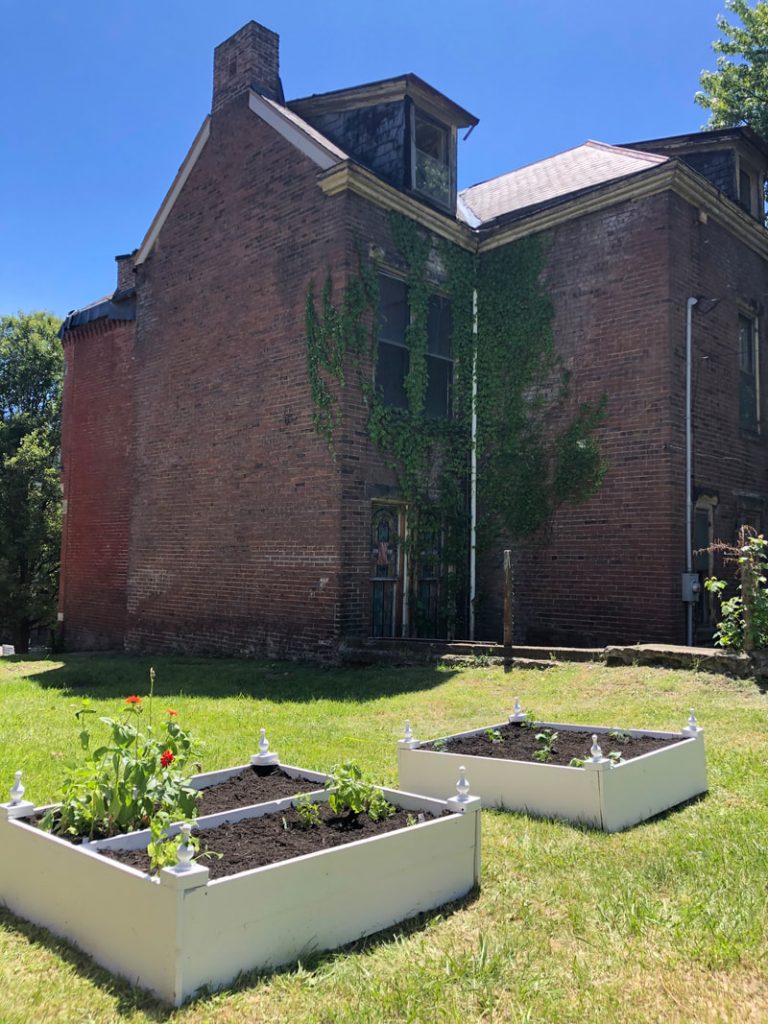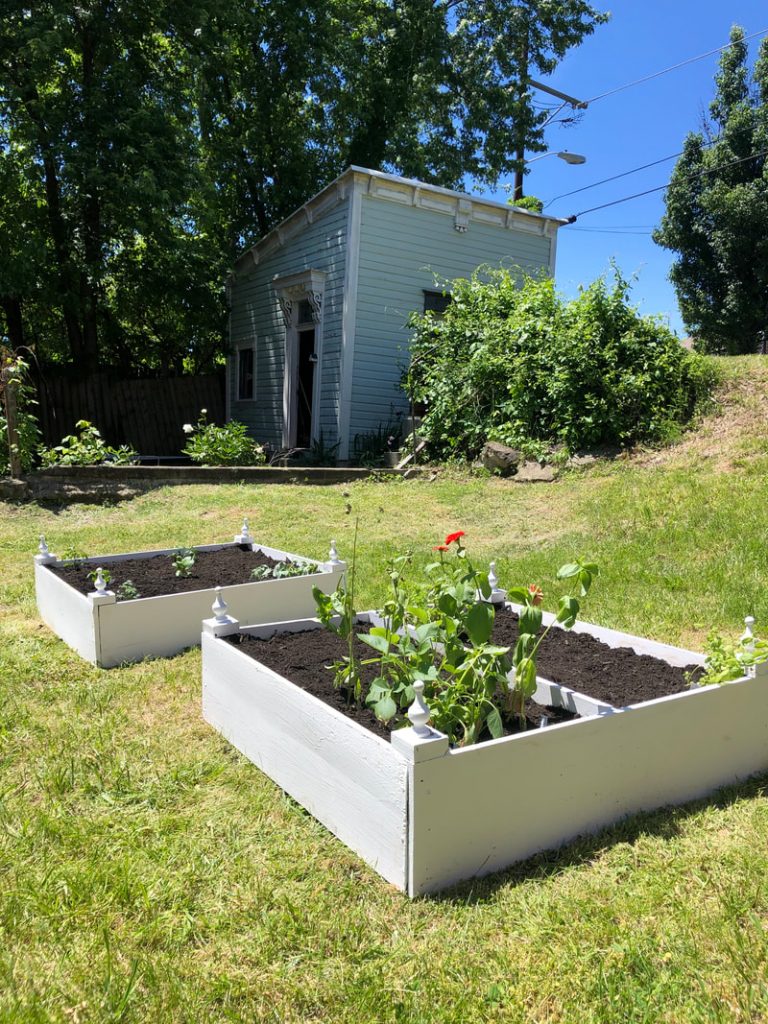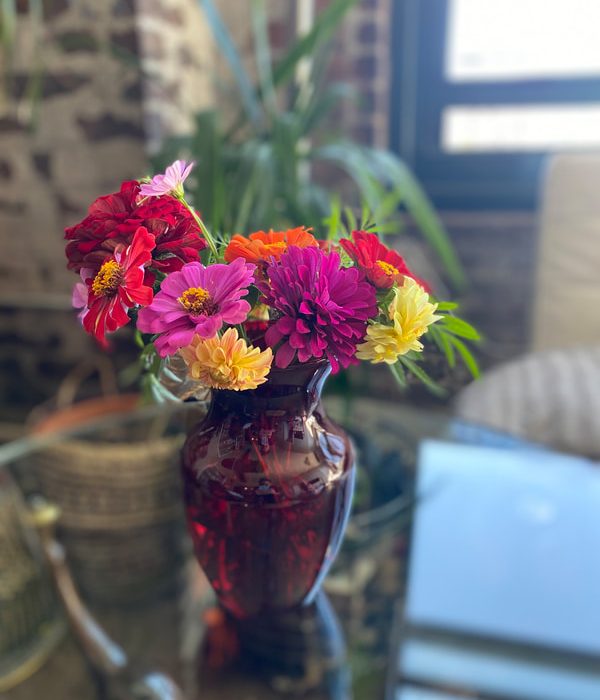The First Project I Tackled at the McLain House
Why Worry About Gardening?
I closed on the McLain house on May 28th, 2020. Spring was inching into summer, and I had a whole season of work ahead of me. So, what was the first project I tackled? Window repairs? Raccoon eviction? Waterproofing? None of the above. The first project I tackled at my 3,400 square foot, three level, ivy covered monster of a house wasn’t even about the house. It was about gardening
And not just any garden. Pretty, raised, painted garden beds. I wanted decorative finials on the corners, and to feel like Ina Garten in the Hamptons, picking heirloom tomatoes, instead of regular Betsy picking mint because it’s the only thing that grows, in East Wheeling.
And while those romantic gardening fantasies were an influence, why I really chose to make container gardens my first project instead of countless other, more pressing tasks, was because I wanted to make a statement. I wanted people in the neighborhood to walk by and see something was different.
This was important to me because The McLain House is in East Wheeling, a neighborhood that has historically been underserved and underappreciated. It’s a neighborhood that suffered the effects of Urban Renewal, and the decimation of community in favor of roadways in the mid-century. It’s a neighborhood where historic homes have fallen into disrepair, and raze or repair orders have become all too common. My own side yard once contained a historic Italianate brick home that raised countless generations. Sometime in the mid-2000s that home was demolished, leaving an empty lot, later parceled in with the McLain house.
I wanted my neighbors to know something different was beginning to take place. The empty lot beside my vacant house was empty no more. And it is a yard, with mowed grass and garden beds, not an empty space owned and cared for by no one. This was no longer a short cut from 14th to the alley, it was a place where someone was doing something (although you’re still welcome to cut through my yard anytime and stop and say hi).

How I Made Them
The dirty little secret about container gardening is that its not *that* cheap. Buying dimensional lumber and soil and plants and so on can easily turn a simple project into an expense on par with an actual weekend getaway. I don’t know about you, but I’d rather spend my extra cash on weekend trips with cocktails and a hot tub, not compost and treated lumber. Disclaimer about this approach: you do get what you pay for. I got attractive, functional garden beds that will not be featured by any woodworking magazine anytime soon. If cedar that will last forever and hand chiseled joints are your jam, that’s great. I however, want cute, manageable, and a project I can actually finish and not agonize over.
So first, I found some salvageable wood. I am extremely fortunate that my boyfriend also bought an old building in Wheeling, that just so happened to have been a cabinet shop, where salvaged materials are abundant. But if you are not in that position, simply begin wood hoarding, and you’ll soon have your own supply. Seriously, dumpster dive, look for people gutting houses, you name it, people are always throwing away perfectly good lumber. Take it, hoard it, thank me later.
I managed to find sixteen pieces of six-foot-long by about 10’’ wide boards, and a handful of square-ish pieces to nail to. The process was simple: Stack two boards, screw into a square vertical piece on the interior used for support, then repeat until you have a square. Once I had a square, I added some decorative finials from woodpecker supply to the corners, painted the entire thing with the heaviest white exterior paint I could find, and called it a day. One of the two beds got a divider running down the middle initially for support, but later I found this helped keep plants in their rightful spots.
Once the paint dried, I took the beds to the house, picked a spot where they’d be visible but out of the way of mowing, and plopped them down. I put newspaper down to deter weeds, then a good layer of sticks and miscellaneous vegetation, and then some compost. Luckily the back patio had several years of decomposing leaves available, so that was shoveled up and dumped in. This filled the beds about 1/3 of the way, and a truckload of dirt from a local landscaping company was enough to fill them the rest of the way, and top with mulch. I got my plants locally, from two wonderful organizations, Russell Nesbitt Services and Grow Ohio Valley.
Russell Nesbitt provides lifestyle opportunities to adults with disabilities, and their seasonal greenhouse provides skills training and employment opportunities for the individuals they work with. They grow the best starter plants, maintain a greenhouse in downtown Wheeling, and the proceeds go directly back into the organization’s programming. I bought tomato, pepper, brussels sprouts and herb starters from them.
Grow Ohio Valley is a local nonprofit organization rethinking the way we approach food justice and access to fresh produce and local groceries. They opened the Public Market last October, brining fresh, local food to downtown Wheeling and addressing a food desert. I purchased Zinnia and mixed wildflower seeds there.

The Harvest
Now, looking back over the past three months, I can’t say everything I planted was a success. I still contend with an enormous groundhog that lives under the mini house, and feasts on my tomatoes. I was able to enjoy fresh herbs all summer, making Mojitos right in the backyard with my mint. On several occasions I brought fresh floral arrangements as hostess gifts, and nothing made me happier than knowing my friend Jenna down the street picked herself a bouquet one day while she was out walking the dog. One day my neighbor Donna, who has lived on 14th street for nearly 50 years, told me she remembered the old Italian couple that owned the McLain house in the 1960s and 70s, growing huge, elaborate gardens that fragranced the whole neighborhood.
And that is why my container gardens are so important to me. They brought life back into a long quiet space. Friends picking flowers, neighbors remembering their neighbor’s grape vines. It’s about people in a neighborhood that often gets brushed off, seeing that their community is special, and that a piece of it will be tended with care.






Betsy,
Your home is magnificent and I admire your tenacity. Keep it up! You inspire many.